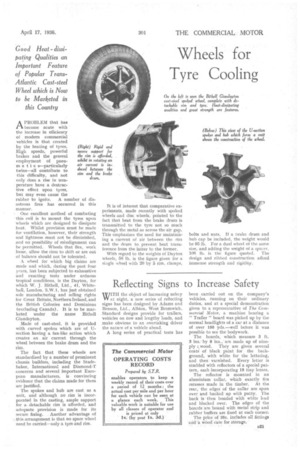Wheels for Tyre Cooling
Page 35

If you've noticed an error in this article please click here to report it so we can fix it.
On the left is seen the Bithell Giandayton cast-steel spoked wheel, complete with detachable rim and tyre. Heat-dissipating qualities and great strength are features.
A PROBLEM that has tA become acute with the increase in efficiency of modern commercial vehicles is that created by the heating of tyres. High speeds, powerful brakes and the general employment of pneu
• ma t ic s..—particularly twins—all contribute to this difficulty, and not only does a rise in temperature have a destructive effect upon tyres, but may even cause the rubber to ignite. A number of disastrous fires has occurred in this manner.
One excellent method of combating this evil is to mount the tyres upon wheels which are designed to dissipate heat. Whilst provision must be made for ventilation, however, their strength and lightness must not he diminished, and no possibility of misalignment can be permitted. Wheels that flex, work loose, allow the rims to shift or are out • of balance should not be tolerated.
A wheel for which big claims are made and which, during the past four years, has been subjected to exhaustive and exacting tests under arduous tropical conditions, is the Dayton, for which W. j. Bithell, Ltd., 41, Whitehall, London, S.W.1, has just obtained sole manufacturing and selling rights for Great Britain, Northern Ireland, and the British Colonies and Dominions (excluding Canada). It is to be marketed under the name Bithell Giandayton.
Made of cast-steel, it is provided with curved spokes which are of Usection having a fan-like action which creates an air current through the wheel between the brake drum and the rim.
The fact that these wheels are standardized by a number of prominent chassis builders, including the Studebaker. International and Diamond-T concerns and several important European manufacturers, is convincing evidence that the claims made for them are justified.
The spokes and hub are cast as a unit, and although no rim is incorporated in the casting, ample support for a detachable rim is afforded, and adequate provision is made for its secure fixing. , Another advantage of • thi,s arrangement is that no spare wheel need be carried—only a tyre and rim. drum. It is of interest that comparative experiments, made recently with spoked wheels and disc wheels, pointed to the fact that heat from the brake drum is transmitted to the tyre not so much through the metal as across the air gap. This emphasizes the need for maintaining a current of air between the rim and the drum to, prevent heat transference from the latter to the former.
With regard to the weights of Dayton wheels, 58 lb. is the figure given for a single wheel with 20 by 5 rim, clamps, bolts and nuts. If a brake drum and hub cap be included, the weight would be 95 lb, For a dual wheel of the same size, and adding the weight of a spacer, 108 lb. is the figure quoted. The design and ribbed construction afford immense strength and rigidity.






























































































